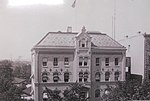Butler Building
Benjamin ButlerBuildings and structures demolished in 1929Demolished buildings and structures in Washington, D.C.Government buildings in Washington, D.C.Houses in Washington, D.C. ... and 2 more
United States Coast and Geodetic SurveyUnited States Public Health Service

The Butler Building was a mansion in Washington, D.C., constructed by Benjamin Franklin Butler. It served as the headquarters of the U.S. Marine Hospital Service, and its successor the Public Health Service, from 1891 until 1929. It also contained a purpose-built fire-proof unit to store archives of the U.S. Coast and Geodetic Survey. It was demolished in 1929 to construct the Longworth House Office Building.
Excerpt from the Wikipedia article Butler Building (License: CC BY-SA 3.0, Authors, Images).Butler Building
Independence Avenue Southeast, Washington
Geographical coordinates (GPS) Address Nearby Places Show on map
Geographical coordinates (GPS)
| Latitude | Longitude |
|---|---|
| N 38.8873 ° | E -77.0085 ° |
Address
Longworth House Office Building
Independence Avenue Southeast 15
20003 Washington
District of Columbia, United States
Open on Google Maps











